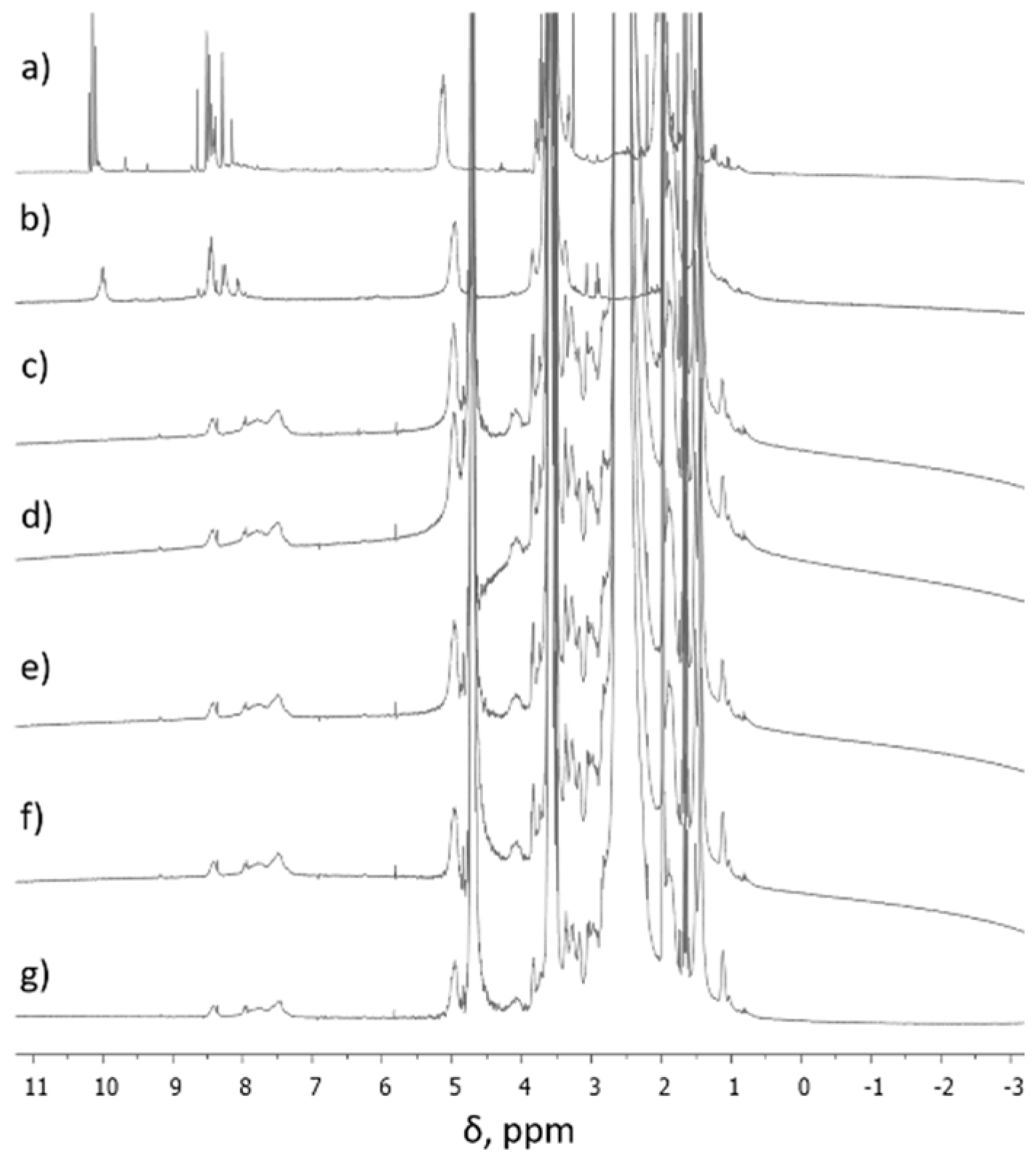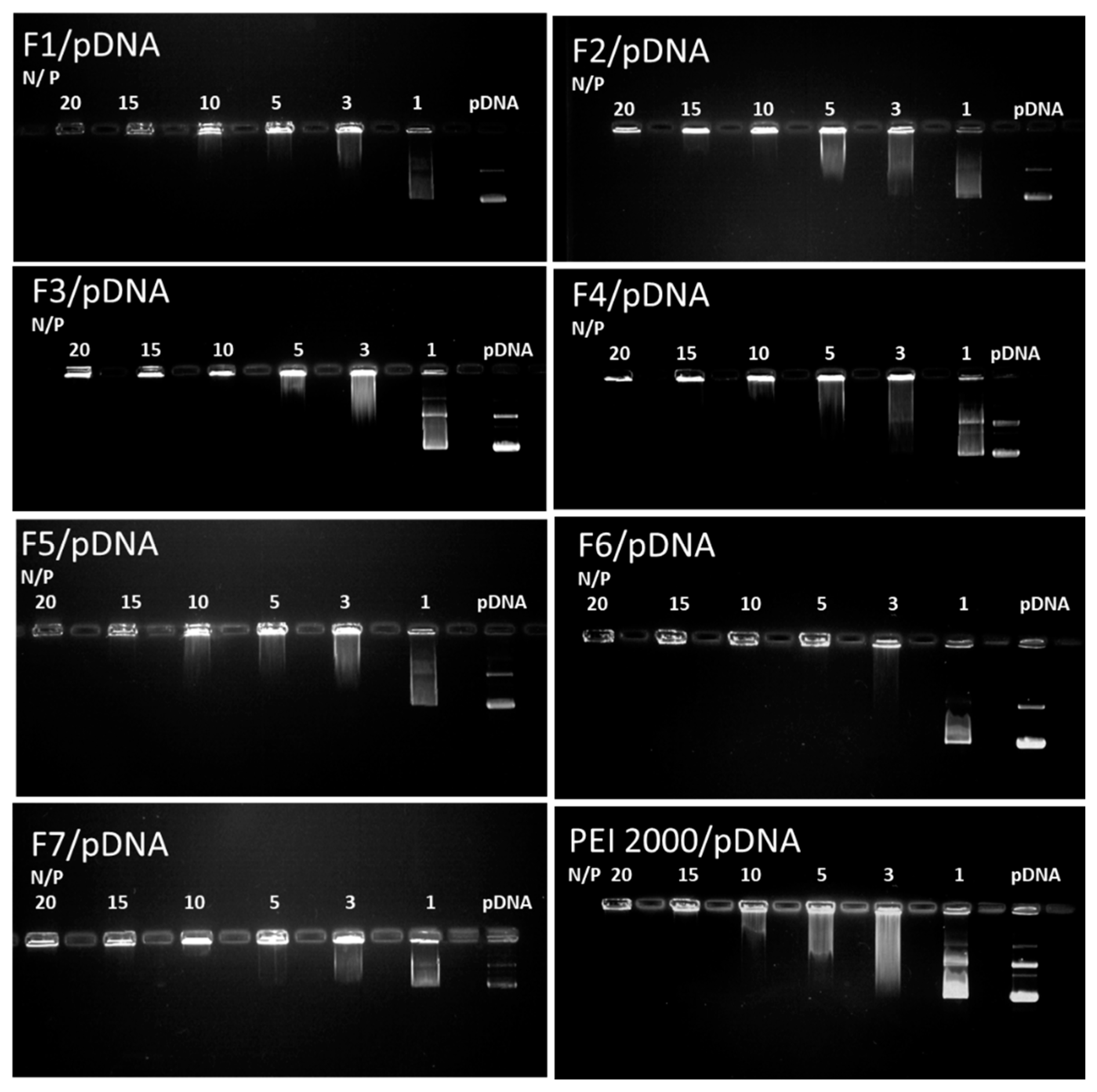Synergistic Effect of Low Molecular Weight Polyethylenimine and Polyethylene Glycol Components in Dynamic Nonviral Vector Structure, Toxicity, and Transfection Efficiency
Abstract
:1. Introduction
2. Results and Discussions
2.1. Formation of DCFs
2.2. Supramolecular Self-Assembling of DCFs
2.3. AFM Studies
2.4. DNA Binding
2.5. DNA Binding Property by Gel Red Assay
2.6. Cytotoxicity and Transfection Efficiency
3. Materials and Methods
3.1. Materials
3.2. Experimental
3.2.1. Synthesis of F1
3.2.2. Synthesis of F2-F5
3.2.3. Synthesis of F6 and F7
3.2.4. Preparation of Polyplexes DCF/pDNA
3.3. Methods
3.3.1. Nuclear Magnetic Rezonance (NMR)
3.3.2. Transmission Electron Microscopy (TEM)
3.3.3. Atomic Force Microscopy (AFM)
3.3.4. Agarose Gel Retardation Assay
3.3.5. Gel Red Exclusion Assay
3.3.6. Cell Cultures
3.3.7. In Vitro Cytotoxicity Study (MTS Assay)
3.3.8. In Vitro Gene Transfection Study
3.3.9. Statistical Analysis
4. Conclusions
Supplementary Materials
Author Contributions
Funding
Acknowledgments
Conflicts of Interest
References
- Ginn, S.L.; Amaya, A.K.; Alexander, I.E.; Edelstein, M.; Abedi, M.R. Gene therapy clinical trials worldwide to 2017: An update. J. Gene. Med. 2018, 20, e3015. [Google Scholar] [CrossRef]
- Hanna, E.; Rémuzat, C.; Auquier, P.; Toumi, M. Gene therapies development: Slow progress and promising prospect. JMAHP 2017, 5, 1265293. [Google Scholar] [CrossRef]
- Dunbar, C.E.; High, K.A.; Joung, J.K.; Kohn, D.B.; Ozawa, K.; Sadelain, M. Gene therapy comes of age. Science 2018, 359, eaan4672. [Google Scholar] [CrossRef]
- Thapa, B.; Narain, R. Mechanism, current challenges and new approaches for non viral gene delivery. In Polymers and Nanomaterials for Gene Therapy; Narain, R., Ed.; Woodhead Publishing: Sawston, UK, 2016; pp. 1–27. [Google Scholar]
- Muramatsu, S. Gene therapy using adeno-associated virus vectors. Cancer Sci 2018, 109, 1200. [Google Scholar]
- Papadopoulos, K.I.; Wattanaarsakit, P.; Prasongchean, W.; Narain, R. 10 - Gene therapies in clinical trials. In Polymers and Nanomaterials for Gene Therapy; Narain, R., Ed.; Woodhead Publishing: Sawston, UK, 2016; pp. 231–256. [Google Scholar]
- Neu, M.; Fischer, D.; Kissel, T. Recent advances in rational gene transfer vector design based on poly(ethylene imine) and its derivatives. J. Gene. Med. 2005, 7, 992–1009. [Google Scholar] [CrossRef]
- Wu, P.; Chen, H.; Jin, R.; Weng, T.; Ho, J.K.; You, C.; Zhang, L.; Wang, X.; Han, C. Nonviral gene delivery systems for tissue repair and regeneration. J. Transl. Med. 2018, 16, 29. [Google Scholar] [CrossRef]
- Ailincai, D.; Tartau Mititelu, L.; Marin, L. Drug delivery systems based on biocompatible imino-chitosan hydrogels for local anticancer therapy. Drug Deliv. 2018, 25, 1080–1090. [Google Scholar] [CrossRef]
- Zakeri, A.; Kouhbanani, M.A.J.; Beheshtkhoo, N.; Beigi, V.; Mousavi, S.M.; Hashemi, S.A.R.; Karimi Zade, A.; Amani, A.M.; Savardashtaki, A.; Mirzaei, E.; et al. Polyethylenimine-based nanocarriers in co-delivery of drug and gene: A developing horizon. Nano Rev. Exper. 2018, 9, 1488497. [Google Scholar] [CrossRef]
- Neuberg, P.; Kichler, A. Chapter Nine - Recent Developments in Nucleic Acid Delivery with Polyethylenimines. In Advances in Genetics; Huang, L., Liu, D., Wagner, E., Eds.; Academic Press: San Diego, CA, USA, 2014; Volume 88, pp. 263–288. [Google Scholar]
- Olden, B.R.; Cheng, Y.L.; Yu, J.L.; Pun, S.H. Cationic polymers for non-viral gene delivery to human T cells. J. Control Release 2018, 282, 140–147. [Google Scholar] [CrossRef]
- Funhoff, A.M.; van Nostrum, C.F.; Koning, G.A.; Schuurmans-Nieuwenbroek, N.M.E.; Crommelin, D.J.A.; Hennink, W.E. Endosomal Escape of Polymeric Gene Delivery Complexes Is Not Always Enhanced by Polymers Buffering at Low pH. Biomacromolecules 2004, 5, 32–39. [Google Scholar] [CrossRef] [PubMed]
- Wang, Y.; Zheng, M.; Meng, F.; Zhang, J.; Peng, R.; Zhong, Z. Branched Polyethylenimine Derivatives with Reductively Cleavable Periphery for Safe and Efficient In Vitro Gene Transfer. Biomacromolecules 2011, 12, 1032–1040. [Google Scholar] [CrossRef]
- Clima, L.; Ursu, E.L.; Cojocaru, C.; Rotaru, A.; Barboiu, M.; Pinteala, M. Experimental design, modeling and optimization of polyplex formation between DNA oligonucleotides and branched polyethylenimine. Org. Biomol. Chem. 2015, 13, 9445–9456. [Google Scholar] [CrossRef] [PubMed]
- Paul, A.; Eun, C.J.; Song, J.M. Cytotoxicity mechanism of non-viral carriers polyethylenimine and poly-l-lysine using real time high-content cellular assay. Polymer 2014, 55, 5178–5188. [Google Scholar] [CrossRef]
- Godbey, W.T.; Barry, M.A.; Saggau, P.; Wu, K.K.; Mikos, A.G. Poly(ethylenimine)-mediated transfection: A new paradigm for gene delivery. J. Biomed. Mater. Res. 2000, 51, 321–328. [Google Scholar] [CrossRef]
- Yao, W.J.; Cheng, X.; Fu, S.X.; Yan, G.Q.; Wang, X.; Tang, R.P. Low molecular weight polyethylenimine-grafted soybean protein gene carriers with low cytotoxicity and greatly improved transfection in vitro. J. Biomater. Appl. 2018, 32, 957–966. [Google Scholar] [CrossRef] [PubMed]
- Wiseman, J.W.; Goddard, C.A.; McLelland, D.; Colledge, W.H. A comparison of linear and branched polyethylenimine (PEI) with DCChol/DOPE liposomes for gene delivery to epithelial cells in vitro and in vivo. Gene Ther. 2003, 10, 1654. [Google Scholar] [CrossRef]
- Remant Bahadur, K.C.; Uludağ, H. 2 - PEI and its derivatives for gene therapy. In Polymers and Nanomaterials for Gene Therapy; Narain, R., Ed.; Woodhead Publishing: Sawston, UK, 2016; pp. 29–54. [Google Scholar]
- Moghimi, S.M.; Symonds, P.; Murray, J.C.; Hunter, A.C.; Debska, G.; Szewczyk, A. A two-stage poly(ethylenimine)-mediated cytotoxicity: Implications for gene transfer/therapy. Mol. Ther. 2005, 11, 990–995. [Google Scholar] [CrossRef]
- Deng, R.; Yue, Y.; Jin, F.; Chen, Y.; Kung, H.-F.; Lin, M.C.M.; Wu, C. Revisit the complexation of PEI and DNA — How to make low cytotoxic and highly efficient PEI gene transfection non-viral vectors with a controllable chain length and structure? J. Contr. Rel. 2009, 140, 40–46. [Google Scholar] [CrossRef]
- Uritu, C.M.; Varganici, C.D.; Ursu, L.; Coroaba, A.; Nicolescu, A.; Dascalu, A.I.; Peptanariu, D.; Stan, D.; Constantinescu, C.A.; Simion, V.; et al. Hybrid fullerene conjugates as vectors for DNA cell-delivery. J. Mater. Chem. B 2015, 3, 2433–2446. [Google Scholar] [CrossRef]
- Uritu, C.M.; Calin, M.; Maier, S.S.; Cojocaru, C.; Nicolescu, A.; Peptanariu, D.; Constantinescu, C.A.; Stan, D.; Barboiu, M.; Pinteala, M. Flexible cyclic siloxane core enhances the transfection efficiency of polyethylenimine-based non-viral gene vectors. J. Mater. Chem. B 2015, 3, 8250–8267. [Google Scholar] [CrossRef]
- Ardeleanu, R.; Dascalu, A.I.; Neamtu, A.; Peptanariu, D.; Uritu, C.M.; Maier, S.S.; Nicolescu, A.; Simionescu, B.C.; Barboiu, M.; Pinteala, M. Multivalent polyrotaxane vectors as adaptive cargo complexes for gene therapy. Polymer Chem. 2018, 9, 845–859. [Google Scholar] [CrossRef]
- Huang, F.-W.; Wang, H.-Y.; Li, C.; Wang, H.-F.; Sun, Y.-X.; Feng, J.; Zhang, X.-Z.; Zhuo, R.-X. PEGylated PEI-based biodegradable polymers as non-viral gene vectors. Acta Biomaterialia 2010, 6, 4285–4295. [Google Scholar] [CrossRef]
- Merdan, T.; Kunath, K.; Petersen, H.; Bakowsky, U.; Voigt, K.H.; Kopecek, J.; Kissel, T. PEGylation of Poly(ethylene imine) Affects Stability of Complexes with Plasmid DNA under in Vivo Conditions in a Dose-Dependent Manner after Intravenous Injection into Mice. Bio. Chem. 2005, 16, 785–792. [Google Scholar] [CrossRef]
- Ramamoorth, M.; Narvekar, A. Non viral vectors in gene therapy- an overview. J. Clin. Diagn. Res. 2015, 9, Ge01–Ge06. [Google Scholar] [CrossRef]
- Pinnapireddy, S.R.; Duse, L.; Strehlow, B.; Schafer, J.; Bakowsky, U. Composite liposome-PEI/nucleic acid lipopolyplexes for safe and efficient gene delivery and gene knockdown. Colloids Surf. B Bioint. 2017, 158, 93–101. [Google Scholar] [CrossRef]
- Pinnapireddy, S.R.; Raafat El Assy, M.; Schlote, P.; Bakowsky, U. Glycosylated Artificial Virus-Like Hybrid Vectors for Advanced Gene Delivery. Polymers 2019, 11, 243. [Google Scholar] [CrossRef]
- Suk, J.S.; Xu, Q.; Kim, N.; Hanes, J.; Ensign, L.M. PEGylation as a strategy for improving nanoparticle-based drug and gene delivery. Adv. Drug Deliv. Rev. 2016, 99, 28–51. [Google Scholar] [CrossRef]
- Godbey, W.T.; Wu, K.K.; Mikos, A.G. Tracking the intracellular path of poly(ethylenimine)/DNA complexes for gene delivery. Proc. Natl. Acad. Sci. USA 1999, 96, 5177. [Google Scholar] [CrossRef]
- Bernkop-Schnurch, A. Strategies to overcome the polycation dilemma in drug delivery. Adv. Drug Deliv. Rev. 2018, 136–137, 62–72. [Google Scholar] [CrossRef]
- Clima, L.; Peptanariu, D.; Pinteala, M.; Salic, A.; Barboiu, M. DyNAvectors: Dynamic constitutional vectors for adaptive DNA transfection. Chem. Commun. (Camb) 2015, 51, 17529–17531. [Google Scholar] [CrossRef]
- Turin-Moleavin, I.A.; Doroftei, F.; Coroaba, A.; Peptanariu, D.; Pinteala, M.; Salic, A.; Barboiu, M. Dynamic constitutional frameworks (DCFs) as nanovectors for cellular delivery of DNA. Org. Biomol. Chem. 2015, 13, 9005–9011. [Google Scholar] [CrossRef]
- Catana, R.; Barboiu, M.; Moleavin, I.; Clima, L.; Rotaru, A.; Ursu, E.L.; Pinteala, M. Dynamic constitutional frameworks for DNA biomimetic recognition. Chem. Commun. 2015, 51, 2021–2024. [Google Scholar] [CrossRef]
- Craciun, B.F.; Vasiliu, T.; Marangoci, N.; Pinteala, M.; Clima, L. Pegylated squalene: A biocomptible polymer as precursor for drug delivery. Rev. Roum. Chim. 2018, 63, 621–628. [Google Scholar]
- Pricope, G.; Pinteala, M.; Clima, L. Dynamic self-organazing systems for DNA delivery. Rev. Roum. Chim. 2018, 63, 613–619. [Google Scholar]
- Couvreur, P. “Squalenoylation” : A new approach to the design of anticancer and antiviral nanomedicines. B Acad. Nat. Med. Paris 2009, 193, 663–673. [Google Scholar]
- Desmaele, D.; Gref, R.; Couvreur, P. Squalenoylation: A generic platform for nanoparticular drug delivery. J. Contr. Release 2012, 161, 609–618. [Google Scholar] [CrossRef]
- Lepeltier, E.; Bourgaux, C.; Rosilio, V.; Poupaert, J.H.; Meneau, F.; Zouhiri, F.; Lepetre-Mouelhi, S.; Desmaele, D.; Couvreur, P. Self-Assembly of Squalene-Based Nucleolipids: Relating the Chemical Structure of the Bioconjugates to the Architecture of the Nanoparticles. Langmuir 2013, 29, 14795–14803. [Google Scholar] [CrossRef]
- David, G.; Clima, L.; Calin, M.; Constantinescu, C.A.; Balan-Porcarasu, M.; Uritu, C.M.; Simionescu, B.C. Squalene/polyethylenimine based non-viral vectors: Synthesis and use in systems for sustained gene release. Polym. Chem. 2018, 9, 1072–1081. [Google Scholar] [CrossRef]
- Ursu, E.-L.; Doroftei, F.; Peptanariu, D.; Pinteala, M.; Rotaru, A. DNA-assisted decoration of single-walled carbon nanotubes with gold nanoparticles for applications in surface-enhanced Raman scattering imaging of cells. J. Nanopart Res. 2017, 19, 181. [Google Scholar] [CrossRef]
- Zhang, X.; Tang, W.; Yang, Z.; Luo, X.; Luo, H.; Gao, D.; Chen, Y.; Jiang, Q.; Liu, J.; Jiang, Z. PEGylated poly(amine-co-ester) micelles as biodegradable non-viral gene vectors with enhanced stability, reduced toxicity and higher in vivo transfection efficacy. J. Mater. Chem. B 2014, 2, 4034–4044. [Google Scholar] [CrossRef]
- Aravindan, L.; Bicknell, K.A.; Brooks, G.; Khutoryanskiy, V.V.; Williams, A.C. Effect of acyl chain length on transfection efficiency and toxicity of polyethylenimine. Int. J. Pharm. 2009, 378, 201–210. [Google Scholar] [CrossRef]
Sample Availability: Samples of the compounds are available from the authors. |







| Compound | SQ-PEG-NH2 | TA | NH2-PEG-NH2 | PEI2000 |
|---|---|---|---|---|
| F1 | 1 | 1 | 0 | 1.5 |
| F2 | 1 | 1 | 0 | 2 |
| F3 | 1 | 1 | 0 | 2.5 |
| F4 | 1 | 1 | 0 | 3 |
| F5 | 1 | 1 | 0 | 3.5 |
| F6 | 1 | 1 | 1 | 1.5 |
| F7 | 1 | 1 | 1 | 2 |
© 2019 by the authors. Licensee MDPI, Basel, Switzerland. This article is an open access article distributed under the terms and conditions of the Creative Commons Attribution (CC BY) license (http://creativecommons.org/licenses/by/4.0/).
Share and Cite
Craciun, B.F.; Gavril, G.; Peptanariu, D.; Ursu, L.E.; Clima, L.; Pinteala, M. Synergistic Effect of Low Molecular Weight Polyethylenimine and Polyethylene Glycol Components in Dynamic Nonviral Vector Structure, Toxicity, and Transfection Efficiency. Molecules 2019, 24, 1460. https://doi.org/10.3390/molecules24081460
Craciun BF, Gavril G, Peptanariu D, Ursu LE, Clima L, Pinteala M. Synergistic Effect of Low Molecular Weight Polyethylenimine and Polyethylene Glycol Components in Dynamic Nonviral Vector Structure, Toxicity, and Transfection Efficiency. Molecules. 2019; 24(8):1460. https://doi.org/10.3390/molecules24081460
Chicago/Turabian StyleCraciun, Bogdan Florin, Gabriela Gavril, Dragos Peptanariu, Laura Elena Ursu, Lilia Clima, and Mariana Pinteala. 2019. "Synergistic Effect of Low Molecular Weight Polyethylenimine and Polyethylene Glycol Components in Dynamic Nonviral Vector Structure, Toxicity, and Transfection Efficiency" Molecules 24, no. 8: 1460. https://doi.org/10.3390/molecules24081460
APA StyleCraciun, B. F., Gavril, G., Peptanariu, D., Ursu, L. E., Clima, L., & Pinteala, M. (2019). Synergistic Effect of Low Molecular Weight Polyethylenimine and Polyethylene Glycol Components in Dynamic Nonviral Vector Structure, Toxicity, and Transfection Efficiency. Molecules, 24(8), 1460. https://doi.org/10.3390/molecules24081460








